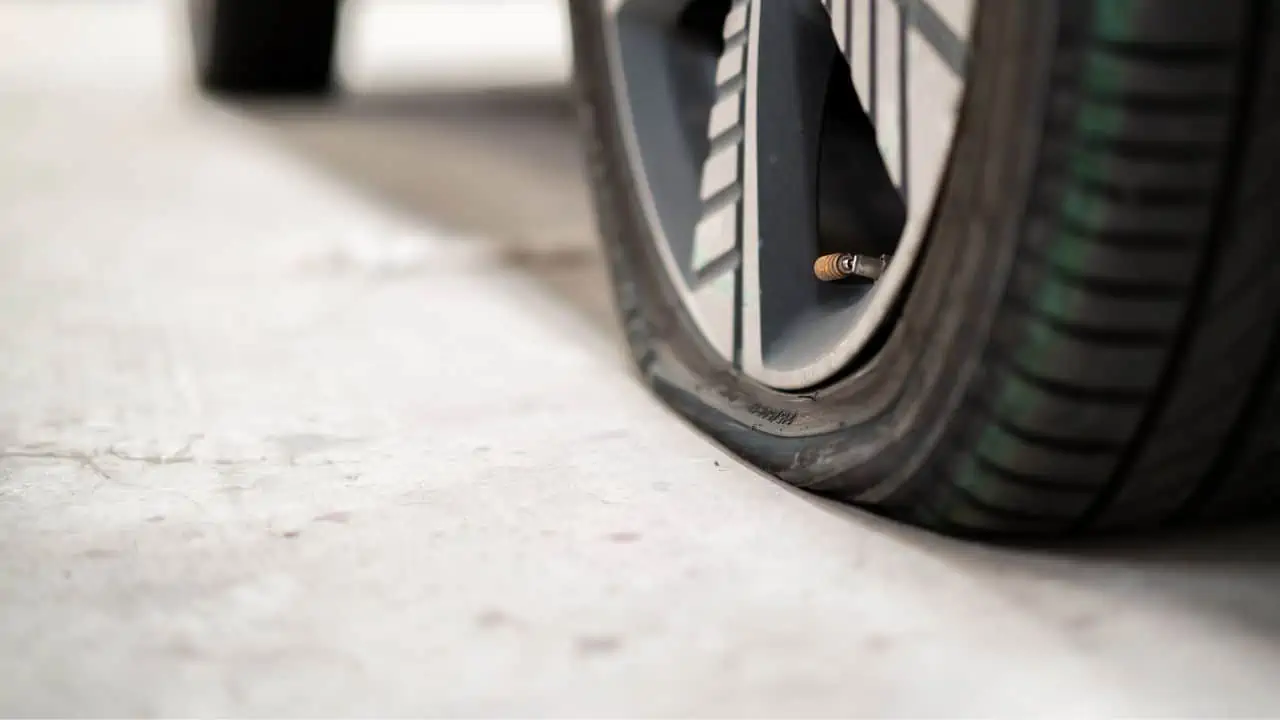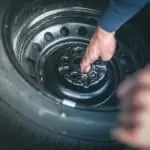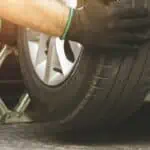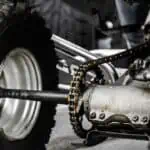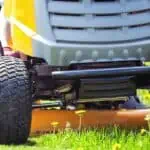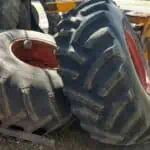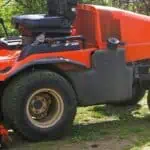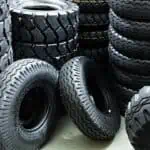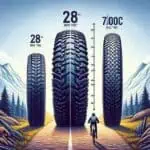If you have a small hole in the sidewall of your tire, there are a few things you can do to fix it. First, try to find the source of the leak and make sure that it is clean. If the leak is coming from the valve stem, you can try replacing the valve stem cap.
If the leak is coming from a puncture in the sidewall, you can try using a patch kit or plugging the hole with a sealant.
- If the hole is less than 1/4 inch, it can be repaired with a tire plug
- Insert the tire plug into the hole from the inside of the tire
- Use a tire patch to cover the hole from the outside of the tire if the gap is larger than 1/4 inch
- Place the patch over the hole and use a vulcanizing solution to bond it in place
You May Like
- Treadlife: N/A
- Tires Only
- Season: All Season, Performance: Performance
- Car Type: Passenger
- 3 PEAK MOUNTAIN SNOWFLAKE CERTIFIED – Experience year-round performance with the Trail Blade…
- WAVE SHAPED SIPES TECHNOLOGY – Enjoy superior traction in all weather conditions, thanks to the…
- EFFICIENT WATER AND SNOW EVACUATION – Drive confidently through wet and snowy roads as the four…
- STABLE AND PRECISE HANDLING – The linked center rib design of the Trail Blade A/T tires ensures…
- Treadlife: N/A
- Tire Only
- Season: All Season, Performance: Performance
- Car Type: Passenger
- Treadlife: N/A
- Tires Only
- Season: All Season, Performance: High Performance
- Car Type: Passenger
- Front Size: 25×8-12 – Rear Size: 25×10-12 | Wheel (Rim) Diameter: Front 12 in – Rear 12 in
- Directional angled knobby tread design great in most terrain with high performance on trails…
- Heavy 6 ply rated construction resists punctures and abrasions.
- Lug depth and pattern offers enhanced skid and traction control, great in cross country or…
How to Fix Small Hole in Sidewall of Tire?
Can You Plug a Small Hole in Sidewall?
If you have a small hole in your sidewall, there are a few different ways that you can go about fixing it. The first option is to simply use a tire plug. This is a quick and easy fix that anyone can do, and it will hold up for the foreseeable future.
If you want a more permanent solution, you can always patch the hole from the inside with a piece of rubber or plastic. This will take some time and effort, but it will ultimately be a much stronger repair.
Can a Puncture in the Sidewall Be Repaired?
A puncture in the sidewall of a tire cannot be repaired and the tire must be replaced. The sidewall is made of rubber and reinforced with nylon or other materials, and once it has been punctured, it cannot be sealed. The only way to repair a puncture in the sidewall is to replace the tire.
Pinhole in Tire Sidewall
A pinhole in a tire sidewall is a small hole or puncture in the tire that can cause air to leak out. This type of damage is usually caused by a sharp object, such as a nail or piece of glass. While a pinhole may not seem like a big deal, it can be quite dangerous.
If the hole is large enough, it can cause the tire to blow out while you’re driving, which could lead to an accident. It’s important to inspect your tires regularly for any signs of damage, including holes or punctures in the sidewall. If you notice a problem, take your car to a qualified mechanic or tire specialist right away so they can fix the issue before it becomes dangerous.
Is It Legal to Patch a Tire on the Sidewall
Is It Legal to Patch a Tire on the Sidewall?
The sidewall of a tire is the portion of the tire that extends from the bead to the shoulder. The sidewall is what gives the tire its shape and helps support the weight of the vehicle.
It also protects the inner tube and provides a place for treads and other markings.
Most tires have multiple plies of rubber, steel, or nylon cord reinforcement embedded in them for strength. These materials are bonded together with adhesives and vulcanized during manufacturing.
A hole or slash in the sidewall weakens this structure and can cause air leaks or blowouts while driving. For this reason, it’s generally not advisable to patch tires on the sidewall.
If you must patch a sidewall leak, use only an adhesive-backed or “self-sealing” patch specifically designed for tire repair.
These patches contain a layer of adhesive that bonds to both the tire and tube when applied under pressure, creating a watertight seal. Be sure to follow all instructions carefully, as improper installation can void your warranty or result in further damage.
What Causes Hole in Tire Sidewall
Most people don’t know that there are different types of tire sidewall damage. The most common type is called “curb rash.” This is when your tire hits a curb or other object and the sidewall rubs against it, causing the rubber to wear away.
Curb rash can be unsightly, but it’s not usually a serious problem and can be easily fixed with a bit of elbow grease and some sandpaper. The other type of tire sidewall damage is much more serious. It’s called “holes in the sidewall,” and it can happen if you hit a pothole or something else extremely hard.
These holes can range in size from small punctures to large gashes, and they can cause your tire to deflate quickly or even blow out entirely. If you have this type of damage, you should take your car to a mechanic as soon as possible so they can inspect the damage and decide if your tire needs to be replaced. In short, there are two main types of tire sidewall damage: curb rash and holes in the sidewall.
Curb rash is generally not serious and can be fixed at home, while holes in the sidewall are much more dangerous and require professional assistance.
Tire Sidewall Repair Products
When it comes to tire sidewall repair products, there are a few different options to choose from. These products can either be used to patch up a small hole or tear in your sidewall, or they can be used to prevent further damage from occurring. The first option is to use a tire sealant.
This type of product works by sealing the hole or tear in your sidewall, which prevents air from escaping. Sealants can be purchased in an aerosol canister and applied directly to the affected area. Once dry, the sealant will provide a temporary fix that will need to be reapplied every few months.
The second option is to use a tire liner. Tire liners are made of a durable material that adheres to the inside of your tire, and covers any existing holes or tears. They are also effective at preventing new ones from forming.
Liners typically last for the tire’s life but may need to be replaced if they become damaged. Either way, these products can help you extend the life of your tires and avoid costly replacements down the road.
How to Patch Sidewall of Tire
If you have a sidewall puncture on your tire, it’s important to know how to properly patch it. A sidewall puncture can occur from hitting a pothole or curb, and if not repaired correctly, can cause serious damage to your tire. Here’s how to fix a sidewall puncture on your tire:
1. Remove the wheel from the vehicle and dismount the tire.
2. Inspect the puncture site and clean any debris away. It’s important to make sure that the area around the puncture is clean so that the patch will adhere properly.
3. Apply a generous amount of rubber cement or vulcanizing solution to both the inside of the tire and the patch.
4. Place the patch over the hole in the tire and press down firmly so that it adheres well.
5. Trim off any excess patch material with a sharp knife.
6. Re-mount the tire onto the wheel and reinstall it onto your vehicle.
7. Fill the tire with air and check for leaks around the patch before driving.
Hot Patch Tire Sidewall
If you’ve ever driven on a hot summer day, you know how important it is to have good tires. But did you know that there’s more to a tire than just the tread? The sidewall is an important part of the tire that helps protect against punctures and provides support for the weight of the vehicle.
The sidewall is made up of several layers of rubber and other materials. The innermost layer is called the carcass, which is reinforced with steel or Kevlar cords. The carcass provides the strength and shape of the tire.
On top of the carcass are one or more layers of reinforcing material, such as nylon or polyester, which help prevent punctures. Finally, there’s a layer of rubber called the tread, which contacts the road and provides traction.
When a tire gets hot, all of these layers work together to dissipate heat and protect the tire from damage.
That’s why it’s so important to check your tires regularly for signs of wear or damage. If you see any cracks in the sidewall, it’s time to replace your tires.
Tire Sidewall Repair Kit
A tire sidewall repair kit is a specialized kit that allows you to quickly and easily repair a damaged tire sidewall. These kits typically include a variety of tools and materials, such as a puncture sealant, patches, adhesive, and instructions. While not all kits are created equal, most will allow you to effectively repair a damaged tire in minutes.
There are many benefits to using a tire sidewall repair kit, chief among them being convenience and cost-savings. With one of these kits on hand, you won’t have to waste time or money taking your tire to a professional for repairs. Plus, most kits can be used multiple times, so you’ll always be prepared in the event of another flat.
When shopping for a tire sidewall repair kit, it’s important to choose one that includes high-quality materials and easy-to-follow instructions. We’ve put together a list of our favorite kits below to help get you started.
Sidewall Tire Damage
Sidewall tire damage can occur from several different causes. The most common cause is hitting a curb or pothole, which can cause the sidewall to bulge or crack. Other causes include excessive heat, overloading the tire, and using improper inflation pressure.
If you experience sidewall tire damage, it is important to have it repaired or replaced as soon as possible. If left unrepaired, the damage can spread and lead to a blowout. Additionally, sidewall tire damage can affect the handling of your vehicle and make it more difficult to control in an emergency.
If you are unsure whether your tires need to be repaired or replaced, it is best to consult with a professional. They will be able to assess the severity of the damage and recommend the best course of action.
Conclusion
If you have a small hole in the sidewall of your tire, there’s no need to panic. There are a few easy ways to fix it and get back on the road. First, try using a tire patch kit.
These kits come with everything you need to patch up a small hole. If the hole is too big for a patch, you can try using a plug kit. These kits come with a tool that helps you insert a plug into the hole.
Once the plug is in place, it will expand and seal the hole. If neither of these options works, then you’ll need to replace the tire.
